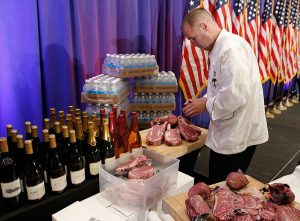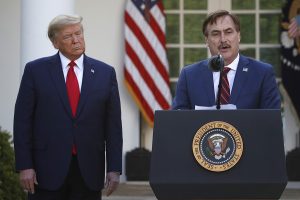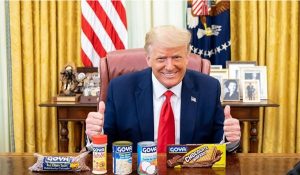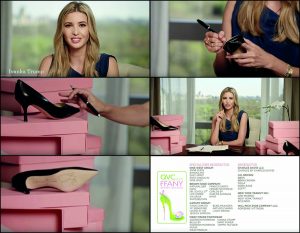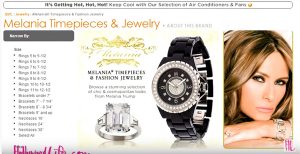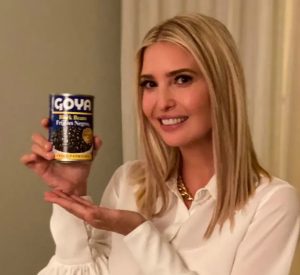How to Fight a Pandemic with Status Elevation: The Home Shopping Governance of Donald J. Trump
In the last few months, US president Donald J. Trump has repeatedly scandalized observers by applying the presentational modes of home shopping television to his public pronouncements on the pandemic. This contribution argues that Trump’s home shopping mode of address is not another in a long series of tasteless aberrations and breaches of protocol. Rather, it is an intrinsic element of his television personality, a source of his political leverage and a key to understanding his mode of governance.
[Fig.1] The Bible Salesman (Source: Screenshot of https://www.newyorker.com/news/daily-comment/an-abuse-of-sacred-symbols-trump-a-bible-and-a-sanctuary)
If Trump gets blown out, Trumpism will be remembered as a luxury good for well-off white people and less a response to economic desperation.
Matthew Zeitlin, July 7, 2020
I
On June 2, 2020, The New Yorker published an article by Evan Osnos entitled “‘An Abuse of Sacred Symbols’: Trump, a Bible, and a Sanctuary” with the above photograph and caption.[1] On June 1, had Trump ordered a teargas attack on peaceful protesters to clear the way for a photo opportunity at St. John’s Church across from the White House. Standing in front of the church, Trump presented a Bible to the camera, a signal to his core constituency, racist white southern evangelicals. The stunt was widely condemned, among others by Mariann Budde, the Episcopalian bishop of Washington D.C., who expressed her outrage that Trump “felt he had the license … to abuse our sacred symbols and our sacred space in that way.” Osnos expressed his disapproval not least through his framing: Trump “held up a Bible and posed with it for the cameras, clasping it to his chest, bouncing it in his hand, turning it to and fro, like a product on QVC.” Describing the photo-op as a “crude simulation of leadership,” Osnos continued: “He assembled a pageant of symbols that he knows have power over others—the Bible, the gun, and the shield. And he tossed them together in a cruel jumble of nonsense.”
QVC, a cable shopping channel founded in 1986—the acronym stands for “Quality Value Convenience”—reaches 360 million households in seven countries: the US, UK, Germany, France, Italy, Japan, and China, i.e. the G7 minus Canada plus the PRC, where QVC operates a joint-venture with state TV. On QVC slick hosts—often celebrities like comedian Joan Rivers—plug fashion, household appliances, and jewelry for phone and online orders. If The New Yorker is the apogee of cultural prestige in American media, QVC is located near the opposite end of that spectrum.
From the height of his standing, Osnos wields the QVC reference for cultural leverage and moral condemnation. But in his indignation, he misses out on its heuristic and analytic power. What the current pandemic throws into high relief is that the home shopping template is not another tasteless aberration or breach of protocol, but an intrinsic element of Trump’s television personality and, therefore, his mode of governing. Foregrounding, as it does, the intimate space of home shopping to obfuscate the macro sites of maintenance and care, the teleshopping template also helps us understand the limitations of Trump’s governance in the face of a global health crisis.
II
In a keynote titled “Poor Old Television” at the 2010 Istanbul NECS conference, Charlotte Brunsdon, a key figure in television studies, offered an ironic paean on how what was arguably still the most powerful audiovisual medium had fallen out of academic fashion: linear television. Trump’s win in 2016 revealed this to be a problem. “Quality TV” had turned television into a safe subject for professors of English. However, the real story of the twenty-first century was the global ascendancy of reality TV. And while much has been written on Big Brother, The Apprentice, which turned a failing tycoon into an emblem of business acumen, only attracted scant attention, mostly as a cautionary tale about neoliberalism.[2] Only when it was too late, i.e. with Trump well on the way to the White House, did television studies really start to pay attention. A dossier in Television and New Media in the summer of 2016 assembled short “ruminations on Trump” as “apotheosis of the new culture of promotionalism” (Negra 2016, 646). One title spelled out the field’s sin of omission—“Don’t misunderestimate the Donald (like we did)”—while Laurie Oulette highlighted “reality TV’s long-established role in governing practices” and its resonance with the “illiberal pressure points of free market political rationalities” to circumscribe the work that should have been done (Ouelette 2016, 649).[3]
Maybe Trump managed to fly under the radar of critical media studies for so long because he has no secret and is “just boring,” as Stephen Colbert recently put it. This may also be why Audience of One, the one book so far on Trump the TV character, thoroughly researched and engagingly written by New York Times TV critic James Poniewozik, contains no earth-shattering relevations (Poniewozik 2019). Still, scholars should have paid attention. After all, there are prominent historical templates like Mussolini’s similarity with Bartolomeo Pagano’s strongman film hero Maciste, which suggests that both “drew on common discourses, images, and commodities” including “the cult of the muscled male body, nationalism, colonialism, stardom, and fashion” (Rich 2015, 188). But then, analogies with twentieth-century fascism only go so far, as they distract “us from how we made Trump over decades” (Moyn 2020).
Considering the fields’ feminist origins, it would be a sexist joke to blame television studies for not saving the world from Trump. But it is not too late for smaller things – for instance to understand why Trump has resorted to the home shopping template with increasing frequency in his response to the pandemic.
Apart from the photo-op, which brought QVC to Evan Osnos’s mind, four episodes offer points of attack: After winning primaries in Michigan and Mississippi on March 8, 2016, Trump plugged Trump products including vodka, steaks, water and wine, some of which had long gone out of production, at his press conference; during the early briefings on the pandemic, Trump promoted the malaria drug Hydroxichloroquine, in which he owned shares;[4] on March 29, he bought Mike Lindell, a teleshopping bedroom gear tycoon known as “The Pillow Guy,” to the Rose Garden to celebrate Trump’s leadership; and on July 15, Trump posted a photo of himself at the Resolute Desk in the Oval Office promoting Goya products, a company which, according to its website, offers “authentic Latino food” and became the focus of a boycott after CEO Robert Unanue delivered another Rose Garden paean to Trump’s leadership. If we further consider that a pro-Trump book from 2016 is called Planes, Steaks and Water: Defending Donald J. Trump (Pruitt 2016) we see, as Trump himself would say, the need to “get to the bottom of this.”
[Fig. 2] Trump-branded products on display at the Trump National Golf Club, Jupiter, Florida, for the press conference after Trump’s primary wins in Michigan and Mississippi on March 8, 2016 (Source: Mychal Watts/WireImage/Getty Images)
[Fig. 3] „My Pillow“ inventor, reformed crack head and home shopping celebrity Mike Lindell praising Donald Tump in the Rose Garden, March 30, 2020 (Source: Alex Brandon/AP, Politico.com)
[Fig. 4] Gawking Goya Products to Chase Latino Votes: Trump at the Resolute Desk on July 2015 (Source: @realdonaldtrump/Instagram 2020)
III
“I admit that I am a QVC shopper”: to illustrate his claim that teleshopping is tied to status anxiety and is a “media ritual of status elevation” David Gudelunas opens his essay QVC: Retail and Ritual (Gudelunas 2002) with a confession.
Teleshopping starts out on local TV in Florida but enters the mainstream in 1986 with QVC, a company founded in West Chester, an affluent suburb of Philadelphia. Under Hollywood executive Barry Diller, who built Fox TV and came to teleshopping through his wife, fashion designer Diane von Furstenberg, QVC became a multinational company in the 1990s, with USD 11 billion in sales in 2019 (up from 8.7 in 2017, and 1.5 times more than Paramount Pictures), 70% of which came from the US market.[5] Unlike that vanishing hallmark of twentieth-century consumerism, the mall, QVC has adapted well to online retailing and now streams three channels on a mail order website. Like the “weepies” of 1950s Hollywood, teleshopping pimarily targets relatively affluent white suburban middle-class women, who represent close to 90% of QVC’s audience.
Gudelunas argues that QVC was “a more successful home shopping channel than its now defunct competitors because it was able to establish a high level of para-social interaction by interacting with guests” (Gudelunas, 108). Para-social interaction is a form of impersonal intimacy which television personalities develop as they address absent audiences as if present (Horton and Wohl 1956). QVC’s distinguishing features include call-in segments introduced by the phrase “let’s go to the phones,” which has become part of the American lexicon. In these segments viewer-shoppers chat up the hosts and gush about products. As Gudelunas argues, “QVC viewer-shoppers are clearly members of a congregation as opposed to an audience” (Gudelunas, 110). Studies of language and behavior in up-scale department stores like Saks Fifth Avenue show that sales personnel strive for the prestige of their wealthy customers. As Mary Bucholtz shows, in the QVC congregation the roles are reversed: the host becomes an aspirational figure and customers “strive for the prestige of the sales representative” (Bucholtz 1999, 356).[6] QVC prices allow for impulse buying, making viewer-shoppers, who often reference their bank balance in calls (Ridgway/Kukar-Kinney 2005) “able to rise up from their current economic position and renew themselves as members of an elevated class” (Gundelunas, 112-13). QVC holds up so well against more prosaic online retailers like Amazon precisely because it is a “media ritual of status elevation” with a focus on non-essential luxury goods.
Status elevation though consumption is also the core of the Trump brand, and it should not surprise us that the extended Trump family has long-standing ties with QVC. In 2007, Trump personally appeared against a backdrop of black boxes with Trump Steaks in gold lettering to signal that the “Trump brand was masculine, decadent, upscale.” Marketed through QVC and the mail order service The Sharper Image, Trump steaks sales failed to exceed five figures after two months and were discontinued, with the trademark expiring in 2014. The Trump women have been more successful. Raising breast cancer awareness while selling shoes and handbags from her Trump Tower apartment, Ivanka has been a familiar face on QVC for years.
[Fig. 5] Ivanka signing shoes for QVC Shoppers in her Trump Tower Apartment, and also supporting breast cancer research (Source: YouTube 2014, https://youtu.be/-ge99mf0540)
Melania Trump’s collection of timepieces and jewelry, which she herself described as “something that you could afford and easily buy on QVC,”[7] reportedly sold out in 45 minutes during the first QVC broadcast in 2010. Melania’s line of caviar-infused skin creams was less successful and remained at the conceptual stage. On “Celebrity Apprentice” former basketball great and personal friend of Kim Jong-Un Dennis Rodman got fired for misspelling Melania’s name on a caviar skin care ad. When Trump became president, Melania continued to cross-fertilize her business with a link to her QVC online shop on her personal White House page, until public outcry forced her to take it down.[8]
[Fig. 6] Something That You Could Afford and Easily Buy on QVC: Melania, Timepieces, and Jewelry (Source: YouTube 2012, https://youtu.be/ID0KKalefqw)
The Trump family has in other words been occupying the community space of the teleshopping congregation for years. Ivanka and Melania may well have contributed to Trump’s political success by attuning QVC’s white middle-class audience to the brand. S.R. Srinivas has shown how in Southern India film fan clubs become political parties, paving the way for the likes of former film stars and long-time Tamil Nadu governors M.K. Ramachandran or Jayalalithaa (Srinivas 2006). A similar form of fluid mobilization could be said to be at work in Trump’s rise. As the authors of a study on Trump as a “networked political brand” write, “the experience of community that emerges from [the convergence of branding and political communication] gains increasing importance” (Billard and Moran 2020, 589). While Lisa Kelly is right to insist that television continues to be central to Trump and political culture even in a “post-TV” age (Kelly 2019), a crucial driver of this experience is Trump’s twitter game, which closely replicates the relationship of host, caller and viewer-shopper that produces the QVC congregation. Poniewozik describes Trump’s twitter personality as a Hobbesian Leviathan. By interacting with followers Trump makes them feel that they are “all part of on mighty body of which he was the head.” In particular, retweets signal “I am not ashamed of you. I am simply of you” (Poniewozik 2019, 191). Similarly, Trump’s brand—status elevation through consumption—thrives on himself being an avid consumer, which is also why news about the President spending his days at the White House watching TV and gobbling up fast food strengthens, rather than undermines, his legitimacy with his followers. And while Trump’s frequent calls into his favorite morning show “Fox and Friends” are a breach of presidential protocol, they redefine the presidency in terms of the teleshopping protocol by demonstrating the soothing, egalitarian ease with which the leader of the free world can move from host to viewer-shopper and back.[9]
Far from a “cruel jumble of nonsense,” the teleshopping template boils the brand of Trump the politician down to its essentials. As I will argue, it also defines his limitations as a leader in a global health crisis.
Parading Trump products after primary wins is not just a rebuttal of criticisms of his track record of business failure: it is a reminder that he is the candidate of status elevation, and he is winning. Inviting Mike Lindell to praise him in the Rose Garden is not just an attempt to stroke his ego: it is a move to strengthen his legitimacy in a moment of crisis through the endorsement of another teleshopping star. The template serves to mobilize the home shopping congregation for political ends. Nowhere was this more glaringly obvious than in early July 2020, when Trump first enlisted QVC star Ivanka and then himself to plug Goya products from the White House, accidentally repositioning Latino staples as white middle class luxury goods in the process.
[Fig. 7] From Shoes to Beans: Ivanaka joining her father’s boycott of the Goya Boycott through her social media accounts (Source: Twitter/Ivanka Trump 2020)
The shopping channel template also sheds light on Trump’s speaking style. Barack Obama put himself on the path to the presidency with a soaring Emersonian speech about unity at the 2004 Democratic National Convention in Boston. Trump’s rally speaking style is famously disjointed and free-flowing, and prepared notes are the death of his appeal. Where Obama strives to enlist the entire citizenry in the arduous task of building a more perfect union (to quote his 2008 speech on race), Trump’s colloquial mode of address offers a ready-made community experience in a congregation that is both open and exclusive. In 2016, CNN and the networks streamed Trump rallies not because they were news, but because they were low-cost, instant gratification reality programming for white middle-class audiences with status anxiety—not good for America, as then CBS head Les Moonves put it, who has since been fired for sexual harassment, but great television (Bond 2016).
And the teleshopping template may even explain the cruelty. If your promise is status elevation for your in-group rather than opportunity for all,[10] and if you believe the economy is a zero-sum game—an idea Trump learned on the Manhattan real estate market, as Josh Marshall points out[11]—then the out-group has to lose, and making the out-group suffer for all to see is an indicator of your success.
Mary Trump, a clinical psychologist and the president’s niece, describes Trump as a Frankenstein monster sewn together from his father’s pathologies (Trump 2020). He can also be described as a self-made Frankenstein of American television and new media, stitched together from the dominant modes of twenty-first-century television. He draws his lifeblood from formats which appear as mere dregs and refuse from a patrician critical point of view but which have considerable purchase with audiences, with teleshopping most strongly resonating with Trump’s personal brand. Trump’s legitimacy, rather than vertical and reasoned, is fluid, mobile, and horizontal, based on affectual ties of instant gratification which are impervious to the deferred satisfaction calculus which political science models usually assume. It is not coincidence that Trump voters are often described as fans rather than party loyalists (Einwächter 2020, Hediger 2020). Trump voters are, in any case, affluent: They had twice the income of Clinton voters (Silver 2016) and were typically the rich people in poor places (Blum 2017). Their status anxiety is not existential, and their politics are quite literally luxury politics: Not government of, by and for the people, but governance of status elevation for the already safe and secure who can afford to impulse-buy cruelty to others.
The limitation of Trump’s teleshopping governance in a crisis like the COVID-19 pandemic is this: In it, the only way to care is to care for yourself through consumption. This is why rather than let experts speak and assume the role of comforter-in-chief, the president used the briefings on the pandemic as a teleshopping platform for products that would make the virus go away, up to, and including, bleach. When Boris Johnson brandished his new-born baby boy about in the tabloids just as the failure of his COVID-19 strategy became apparent, he engaged in diversion. When Trump projects the para-social intimacy of home shopping where a public space of care and grieving should be built, he is just being himself. But the pandemic is one problem shopping won’t solve. Once that became clear Trump, being Trump, was left with a choice of wishing the virus away or ignoring it. Ever the glutton, he picked both.
“The television culture that Donald Trump grew up with, thrived in, and embodies is not the only kind of television,” writes Poniewozik, trying to keep our hope for a better kind of television, and thus a better world, alive (Poniewozik 2019, 273). Home shopping, we can infer, is not that kind of television. Considering QVC’s robust business, it is also not going away any time soon. Which may have political repercussions even after Trump no longer occupies the White House. Ivanka has been derided as a mere “handbag designer” who erroneously got to be in the same room with Angela Merkel. But being a handbag designer is what got her there in the first place. In the age of home shopping governance, a QVC pedigree confers political standing. And Trump has encouraged the “Pillow Guy,” Mike Lindell, to run for office.[12] In the future, America may well be governed by dynasties of home shopping hosts rather than the Adams, Kennedys, Bushes, or Clintons of yore.
Is the world’s last, best hope, then, for a teleshopping host who understands that the economy is not a zero-sum game?
Mary Trump argues that we need to focus not on her uncle but on those who surround and enable him. This includes the whole congregation. It has been said that supporting Trump is a moral choice. Home shopping governance also makes it a matter of taste. And taste, as John Ruskin once said, is not a question of morality. It is the only morality.
+
+ +
Trump contracted COVID-19 in September. He was treated at Walter Reed Medical Center with the REGN-COV2 antibody cocktail developed by Regeneron Pharmaceuticals, a company run by a major Trump donor. Upon returning to the White House, Trump praised the treatment in a brief television address and said: “That’s what I want for everybody”. The “Lincoln Project”, a Political Action Committee of disgruntled Republican operatives known for their well-crafted anti-Trump TV ads, edited and framed the key parts of the speech as a 1980s style home shopping ad (https://vimeo.com/470748710/b93b5371d4). The Enyclopedia Britannica defines satire as a genre “in which vices, follies, abuses and shortcomings are held up to ridicule, ideally with the intent of shaming individuals, corporations, government, or society itself into improvement.” As satire, the Lincoln Project video fails because Trump knows no shame, and because he has no room for self-improvement. He is exactly what they video says he is. What the video does show is a breakthrough in the home shopping governance response to the pandemic: Trump has finally found a product which, different from hydroxychloroquine and bleach, appears to work, reflects his lifestyle and can be sold, with his personal endorsement, on television.
References
Billard, Thomas J., Rachel E. Moran. 2020. “Networked political brands: Consumption, community, and political expression in contemporary culture,” Media, Culture & Society, Vol. 42, No. 4, 588-604.
Blum, Philip. 2017. “Places that backed Trump skewed poor; voters who backed Trump skewed wealthier,” Washington Post, December 29, 2017. https://www.washingtonpost.com/news/politics/wp/2017/12/29/places-that-backed-trump-skewed-poor-voters-who-backed-trump-skewed-wealthier/ (accessed July 18, 2020)
Bond, Paul. 2016. “Les Moonves on Donald Trump: ‘It May Not Be Good for America, but it’s Damn Good for CBS,’” Hollywood Reporter, February 29, 2016. https://www.hollywoodreporter.com/news/leslie-moonves-donald-trump-may-871464 (accessed July 18, 2020).
Bucholtz, Mary. 1999. “Purchasing Power. The Gender and Class Imaginary of the Shopping Channel,” in: Reinventing Identities: The Gendered Self in Discourse, edited by Mary Bucholtz, A.C. Liang, Laurel A. Sutton, 348-368. Oxford: Oxford University Press.
Couldry, Nick. 2008. “Reality TV, or the Secret Theater of Neoliberalism,” The Review of Education, Pegagoy, and Cultural Studies, Vol. 30: 3-13.
Couldry, Nick, Jo Littler. 2011. “Work, Power, and Performance: Analysing the ‘Reality,’ Game of The Apprentice,” Cultural Sociology, Vol. 5, No. 2: 263-279.
Cox Richardson, Heather. 2020. How the South Won the Civil War: Oligarchy, Democracy, and the Continuing Fight for the Soul of America. Oxford, New York: Oxford University Press.
Einwächer, Sophie. 2020. “Das Marken-‘Fan-omen’ Trump: Ein Exzess der Mediatisierung von Politik,” Trump und das Fernsehen. Medien, Realität, Affekt, Politik, edited by Dominik Maeder, Herbert Schwaab, Stephan Trinkaus, Anne Ulrich and Tanja Weber, 308-340. Cologne: Herbert von Halem.
Gudelunas, David. 2002. “QVC: Retail and Ritual,” Journal of American and Comparative Cultures, Vol. 25, No. 2, 105-119.
Hediger, Vinzenz. 2020. “Warum lieben ihn so viele?,” Frankfurter Allgemeine Zeitung, October 7, 2020. URL: 11. https://www.faz.net/aktuell/feuilleton/trump-als-idol-warum-ihn-so-viele-lieben-16988988.html.
Horton, Donald, Richard Wohl. 1956. “Mass communication and para-social interaction: Observation on intimacy at a distance.” Psychiatry. 19 (3): 215–229.
Kelly, Lisa W. 2019. ”Authentic” Men and “Angry” Women. Trump, Reality TV, and Gendered Constructions of Business and Politics. In: C. Happer, A. Hosking, W. Merrin (eds.) Trump’s Media War. London: Palgrave McMillan, 87-99.
Maeder, Dominik, Herbert Schwaab, Stefan Trinkhaus, Anne Ulrich, Tanja Weber (eds.) Trump und das Fernsehen. Medien, Realität, Affekt, Politik. Köln: Herbert von Halem.
Moyn, Samuel. 2020. “The Trouble with Comparisons,” New York Review of Books, May 19, 2020. https://www.nybooks.com/daily/2020/05/19/the-trouble-with-comparisons/ (accessed July 18, 2020)
Negra, Diane. 2016. “The Reality Celebrity of Donald Trump,” in: Television and New Media, Vol. 17, No. 7 (2016).
Ouelette, Laurie. 2016. The Trump Show, in: Television and New Media, Vol. 17, No. 7 (2016), 647-650.
Poniewozik, James. 2019. Audience of One: Donald Trump, Television, and the Fracturing of America, New York: W.W. Norton.
Pruitt, A.J. 2016. Planes, Stakes, and Water: Defending Donald J. Trump. New York: Gatekeeper Press.
Rich, Jacqueline. 2015. The Maciste Films of Italian Silent Cinema, Bloomington: Indiana University Press.
Ridwgway, Nancy M, Monika Kukar-Kinney. 2005. “‘Hi, I’m A Compulsive Buyer”: A Content Analysis of Themese from Testimonial Telephone Calls at QVC,” in Advances in Consumer Research, Vol. 32, 431-436.
Silver, Nate. 2016. “The Mythology of Trump’s Working Class Support,” FiveThirtyEight, May 3, 2016. https://fivethirtyeight.com/features/the-mythology-of-trumps-working-class-support/ (accessed July 18, 2020)
Srinivas, S.R. 2006. “Stars and Mobilization in South India: What Have Films Got to Do With It?” Postscript, Vol. 25, No. 3.
Trump, Mary. 2020. Too Much and Never Enough: How my Family Created the World’s Most Dangerous Man. New Yok: Simon & Schuster.
Windle, Joel. 2010. “‘Anyone can make it, but there can only be one winner’: modelling neoliberal learning and work on reality television,” Critical Studies in Education, Vol. 51, No. 3: 251-263.
Notes
[1] https://www.newyorker.com/news/daily-comment/an-abuse-of-sacred-symbols-trump-a-bible-and-a-sanctuary (visited August 28, 2020)
[2] E.g. Couldry 2008; Windle 2010; Couldry and Littler 2011.
[3] Interestingly, one of the first collections of in-depth critical studies of Trump and television was published in Germany, where Trump has taken von Stroheim’s succession as “The Man You Love to Hate” across the political spectrum: Maeder/Schwaab/Trinkhaus/Ulrich/Weber 2020.
[4] https://www.forbes.com/sites/lisettevoytko/2020/04/07/trump-has-small-distant-link-to-sanofi-french-drugmaker-of-hydroxychloroquine/#76253c817260 (visited August 28, 2020)
[5] https://www.statista.com/statistics/536530/qvc-revenue/ (visited August 28, 2020)
[6] This role reversal provides a storyline in Amy Sherman-Palladino’s amazon prime series The Marvelous Mrs. Maisel (2017-), whose main character is modelled in part after Joan Rivers. To earn a living after the break-up of her marriage, the eponymous budding comedienne and daughter of well-to do parents takes a job at B. Altman on Fifth Avenue selling cosmetics, a job at which she excels because she used to be a customer there herself.
[7] https://youtu.be/ID0KKalefqw (visited August 28, 2020)
[8] https://www.teenvogue.com/story/melania-trump-jewelry-white-house-website (visited August 28, 2020)
[9] The extent to which the Trump organization operates as a TV company became clear when they trademarked the term “Telerally” after the cancellation of the Republican National Convention in Jacksonville, Florida, to charge customers, like the Republican Party, for “organizing events in the field of politics and political campaigning.” https://www.washingtonpost.com/politics/trumps-company-applied-to-trademark-telerally-then-president-trump-held-a-tele-rally/2020/07/22/0adca60e-cb7f-11ea-bc6a-6841b28d9093_story.html (visited July 26, 2020)
[10] Trump favors oligarchs and has notoriously decorated the Oval Office with a portrait of Andrew Jackson, a genocidal racist, but the president whom his teleshopping governance of status elevation through consumption most strongly echoes may be Theodore Roosevelt. As Heather Cox Richardson writes: “While Lincoln called for a government that helped workingmen rather than oligarchs, Roosevelt’s vision inherently privileged upwardly mobile white men over people of color, independent women, or anyone mired in poverty” (Cox Richardson 2020, 126-127).
[11] https://talkingpointsmemo.com/edblog/for-me-to-win-you-have-to-lose (visited July 28, 2020)
[12] https://www.politico.com/news/2020/03/30/trump-nudging-mypillow-lindell-run-office-156195 (visited July 28, 2020)

